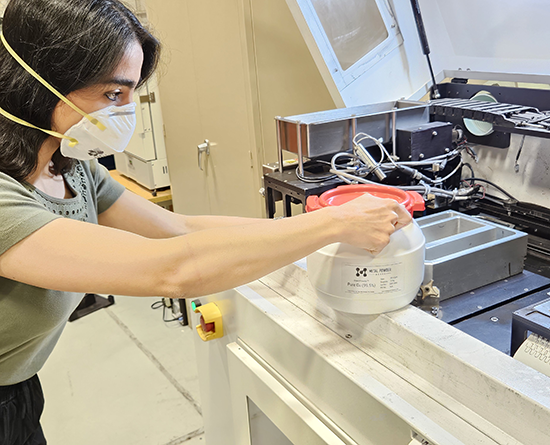Pitt and Metal Powder Works explore innovative applications of non-spherical metal powders in binder jet 3D printing
Nathan Snizaski
Jul 26, 2024

Pitt graduate student Mahsa Beyk Khorasani using a binder jet printer.
Metal powder is crucial as the primary raw material used to create 3D objects layer by layer in additive manufacturing (AM). Many traditional manufacturing methods for raw feedstock powders involve high energy consumption. Metal Powder Works (Clinton, PA) and the University of Pittsburgh have teamed up to explore using copper powder in binder jet 3D printing (BJP), an additive manufacturing method that requires significantly less energy than other methods.
In many manufacturing environments, producing raw feedstock powder used in AM is an expensive, energy-intensive process. Spherical powder is used in the vast majority of metal AM technologies due to its better powder spreading properties and higher density final parts. The partnership between Pitt and Metal Powder Works explored the feasibility of cheaper, non-spherical metal powders that can be used in AM.
“Feedstock powder can be manufactured to be spherical or non-spherical,” says Markus Chmielus, associate professor of mechanical and materials science at the University of Pittsburgh. “For certain applications, you may not want to have spherical powder. You may want to produce something that has non-spherical particles that you then sinter after printing. Or, you may have special applications for filtration for lightweight structures (using non-spherical powder).”
Chmielus says the collaboration with Metal Powder Works centers on combining copper powder with binder jet 3D printing. Copper powder is an inexpensive powder that only takes a little energy consumption to produce. Similarly, binder jet 3D printing is a low energy-intensive additive manufacturing method relative to other methods.
Chmielus explains that the collaboration with Metal Powder Works focuses on integrating copper powder with BJP. Copper powder is a cost-effective material that requires minimal energy to produce, while BJP is a low-energy additive manufacturing method compared to other techniques.
By comparison, atomization is a widely used method for producing high-quality metal powders used in BJP, where a molten metal stream is broken into fine droplets that solidify into powder particles. This process is highly effective in controlling the powders' size, shape, and composition, ensuring consistency and quality, though it can be costly.
“In the atomization technique process, manufacturers use covering gases, such as argon or nitrogen, which is very expensive. Or, they can use plasma atomization, which is also extremely expensive because they have to produce plasma,” says Chmielus. “The method we're exploring with Metal Powder Works operates at room temperature and doesn't require the use of cover gas, making it both cost-effective and energy-efficient for powder production. And this method is applicable for many different materials, not just copper.”
Together with Prof. Chmielus’ group, we envision discovering new products for our process to be used in additive manufacturing. By expanding the application portfolio of our unique powders, we will be able to grow our business now based in Western Pennsylvania.
John Barnes, founder and CEO, Metal Powder Works
The project emerged from conversations between Chmielus and John Barnes, the founder of Metal Powder Works, during local events and professional conferences, where they speculated on the potential behavior of mechanically milled powders in AM processes.
“Binary jet 3D printing is a process that is much more forgiving to two powders that might not be perfectly spherical,” says Chmielus. “That’s why we thought this idea would be a great opportunity to explore by combining our knowledge and resources. Once the call for proposals came out from the Manufacturing PA Program, we thought that this would be a great opportunity to actually start a project together.”
Combining the powder manufacturing capabilities of Metal Powder Works with Pitt’s expertise and research capabilities made this exploration possible. Metal Powder Works produces a variety of powders of different shapes and grades that the research team used to examine the printability of various morphologies and size distributions of copper powder, optimizing printing parameters for specific uses. At the University of Pittsburgh, Chmielus’ team has the necessary AM facilities, characterization capabilities, and knowledge of the printing aspects and sintering.
Chmielus says that an interesting part of the Manufacturing PA collaborations beyond the science of manufacturing is working with former students who are now working in the industry. Eric Rhodes, formerly a graduate student in Chmielus’ lab at Pitt, works as a materials and process engineer at Metal Powder Works. Rhodes aided Chmielus and Barnes in the collaboration.
“Three of my former students who participated in previous Manufacturing PA projects are now employed by local companies in the area, and it’s really interesting to see their career trajectory,” says Chmielus. “Students get an opportunity to interact with company engineers and develop a rapport with them, and they gain the confidence to apply for open positions at the companies where they worked for the project.”
“What’s great about the Manufacturing PA Program partnerships is that students are directly involved with the project,” says Chmielus. “There is a high degree of interaction with our industry partners. Over the years, you can definitely see the impact of these projects, and it's a great avenue to connect students with local manufacturing companies.”